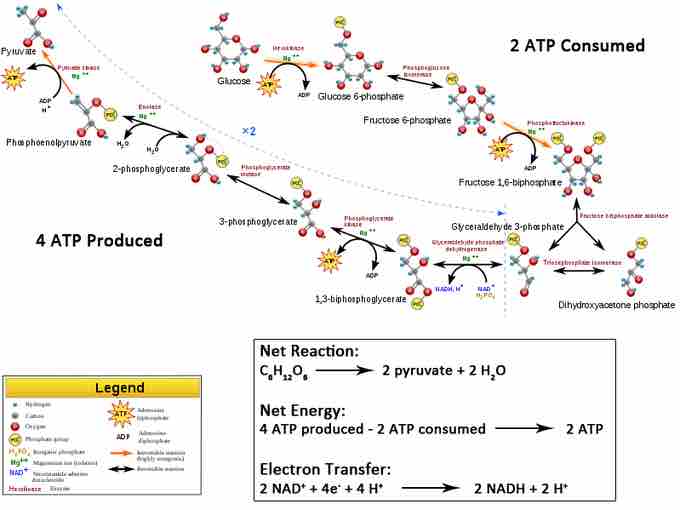Outcomes of Glycolysis
Glycolysis starts with one molecule of glucose and ends with two pyruvate (pyruvic acid) molecules, a total of four ATP molecules, and two molecules of NADH . Two ATP molecules were used in the first half of the pathway to prepare the six-carbon ring for cleavage, so the cell has a net gain of two ATP molecules and 2 NADH molecules for its use. If the cell cannot catabolize the pyruvate molecules further (via the citric acid cycle or Krebs cycle), it will harvest only two ATP molecules from one molecule of glucose.

Glycolysis produces 2 ATP, 2 NADH, and 2 pyruvate molecules
Glycolysis, or the aerobic catabolic breakdown of glucose, produces energy in the form of ATP, NADH, and pyruvate, which itself enters the citric acid cycle to produce more energy.
Mature mammalian red blood cells do not have mitochondria and are not capable of aerobic respiration, the process in which organisms convert energy in the presence of oxygen. Instead, glycolysis is their sole source of ATP. Therefore, if glycolysis is interrupted, the red blood cells lose their ability to maintain their sodium-potassium pumps, which require ATP to function, and eventually, they die. For example, since the second half of glycolysis (which produces the energy molecules) slows or stops in the absence of NAD+, when NAD+ is unavailable, red blood cells will be unable to produce a sufficient amount of ATP in order to survive.
Additionally, the last step in glycolysis will not occur if pyruvate kinase, the enzyme that catalyzes the formation of pyruvate, is not available in sufficient quantities. In this situation, the entire glycolysis pathway will continue to proceed, but only two ATP molecules will be made in the second half (instead of the usual four ATP molecules). Thus, pyruvate kinase is a rate-limiting enzyme for glycolysis.